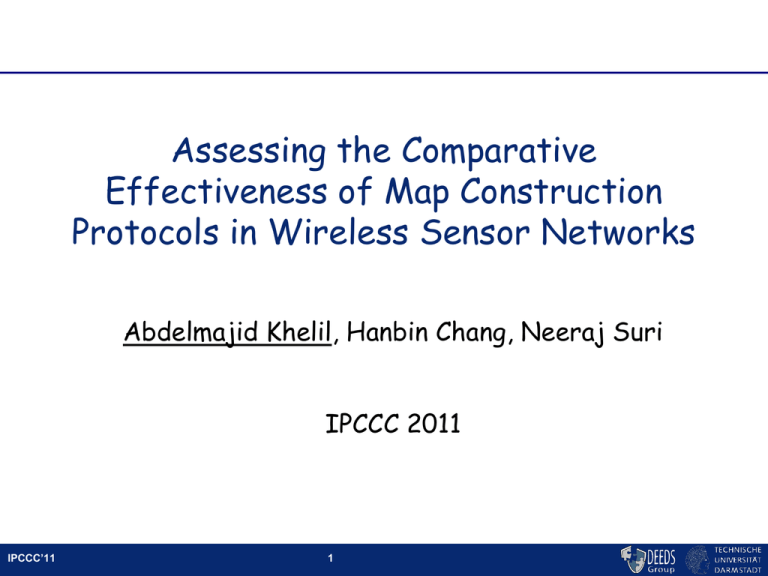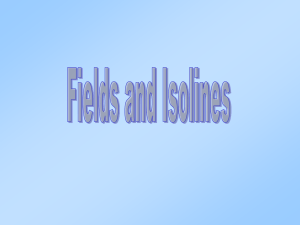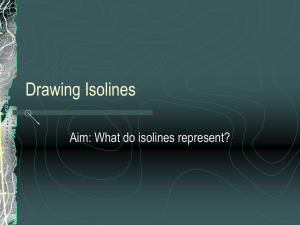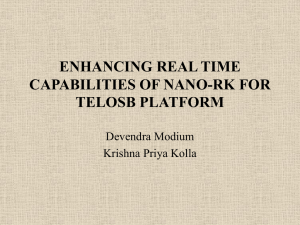Energy-efficient Mapping in Sensor Networks
advertisement

Assessing the Comparative Effectiveness of Map Construction Protocols in Wireless Sensor Networks Abdelmajid Khelil, Hanbin Chang, Neeraj Suri IPCCC 2011 IPCCC’11 1 Maps Maps are an intuitive data representation technique provide a visual representation of an attribute in a certain area; street map, typographic map, world map, etc. Maps for Wireless Sensor Networks (WSN) applications help users to understand sensed physical phenomena help users to make a decision 1000 Y 800 600 400 200 0 0 IPCCC’11 200 400 600 X 800 1000 2 Sensor location (112, 209) (218, 163) (617, 783) (530, 745) (477, 625) (936, 423) (745, 817) (653, 237) ... Sensor value 145 163 158 163 165 157 155 168 ... Map Construction in WSN Naive approach for map construction Energy-efficient approaches for map construction Data collection and processing centrally at sink in-network Energy efficiency (Comm. complexity on sensor nodes) high comm. overhead Map accuracy node-level accuracy, may decrease because of comm. failures Lower comm. overhead may lose detailed information of each individual node Sink Naive Approach IPCCC’11 3 Example of Available Approaches Problem statement and Objectives Several approaches have been proposed. However, Evaluation in carefully selected application scenarios No assessment of the comparative effectiveness of existing approaches: Which is outperforming in Which application/scenario for Which network configuration? IPCCC’11 4 Outline Motivation Classification of Existing Map Construction Approaches Performance Comparison in a Wide Range Scenarios Conclusions IPCCC’11 5 Classification of Map Construction Approaches Map construction approaches for WSN In-network Processing Technique Region Aggregation Data Suppression Data Collection Scheme Tree-based data collection Clusterbased data collection eScan [9] Multi-path data collection CREM [7] Isobar [8] INLR [16] Iso-node based data collection Clusterbased data collection Isolines [14] Iso-map [10,11] Contour Map [18] IPCCC’11 6 CME [19] Region Aggregation Class Basic idea Sensor nodes are ordered hierarchically (clusters, tree ..) Every sensor reports to a dedicated node (cluster head, parent ..) Dedicated node aggregates adjacent similar data to regions 3 Phases: Region Segmentation At each sensor Non-overlapping polygons Vertex representation m m+1 m+2 Data Collection Aggregator determination Tree-based Region Aggregation At aggregator Regions formation Aggregation function, e.g. average IPCCC’11 7 Cluster-based 36 37 37 38 Ring-based 37 Data Suppression Class Basic idea A subset of sensor nodes (iso-nodes) report their value to the sink suppress similar data to be reported Isoline 2 Phases Iso-node Identification what is an iso-node? • has a neighbor with different value how to identify? • broadcast • snoop Isoline Report Generation iso-node based • generated at Iso-node • routed directly to the sink cluster based • generated at cluster-head • Iso-node reports to cluster-head • a local map IPCCC’11 8 36 41 42 38 42 43 37 41 45 Nodes report to the sink Nodes suppress reports to the sink Classification of Map Construction Approaches Map construction approaches for WSN In-network Processing Technique Region Aggregation Data Suppression Data Collection Scheme Tree-based data collection Clusterbased data collection eScan [9] Multi-path data collection CREM [7] Isobar [8] INLR [16] Iso-node based data collection Clusterbased data collection Isolines [14] Iso-map [10,11] Contour Map [18] IPCCC’11 9 CME [19] Selected Map Construction Algorithms The eScan approach [9] Nodes ordered as an aggregation-tree Polygon regions Aggregation function: Average The Isoline approach [14] Local flood to label border nodes Each iso-node reports to the sink Map constructed at the sink [9] Y. Zhao et al. Residual Energy Scan for Monitoring Sensor Networks. In IEEE WCNC, 2002. [14] I. Solis and K. Obraczka. Isolines: Energy-efficient Mapping in Sensor Networks. In ISCC, 2005. IPCCC’11 10 Outline Motivation Classification of Existing Map Construction Approaches Performance Comparison in a Wide Range Scenarios Conclusions IPCCC’11 11 Evaluation Framework: Methodology Selected map construction protocols Region aggregation class: eScan Data suppression class: Isoline Simulations using OMNet++ Network • Area : 300 x 300 m² • Topology: Grid or random Tree-based routing protocol Performance metrics Map accuracy: The ratio of false classified sensors to all sensor nodes. Energy efficiency: Network traffic IPCCC’11 12 Evaluation Framework: Comparative Studies Compare for a wide range of parameters: Impact of physical phenomena properties Hotspot effect range : limited vs. diffusive Hotspot number : 1 vs. n Impact of protocol parameters Sensor value range [0, 60], classes: [0, GV[, [GV, 2GV[ ... • Signal discretization (Granularity value: GV) GV=5…25 Impact of network properties Node density Communication failures Communication range IPCCC’11 13 N=256(16x16)...1225 (35x35) BER=0…10-2 CR=60m Comparison: Impact of Granularity BER=1E-4, N=256, CR=60m Network Traffic [byte] BER=1E-4, N=256, CR=60m Accuracy 1 0.8 0.6 0.4 eScan_grid eScan_random Isoline_grid Isoline_random 0.2 0 5 10 15 20 25 Granularity Value 40000 35000 eScan_grid eScan_random Isoline_grid Isoline_random 30000 25000 20000 15000 10000 5000 0 5 10 15 20 Granularity Value 50 Granularity increases #Isolines and #Iso-nodes decrease -> lower msg overhead Region size increase -> lower msg overhead Accuracy Isoline always outperforms eScan 40 30 20 10 (a) Step value = 5 unit 50 25 Efficiency Isoline outperforms eScan for lower granularities (b) Step value = 25 unit IPCCC’11 25 14 Comparison: Impact of BER Higher BER decreases map accuracy Loss of messages -> gaps in the map • Higher eScan IPCCC’11 accuracy drop for 15 BER increases Loss of messages -> lower msg overhead Overhead reduction is higher for eScan Comparison: Impact of Node Density BER=1E-4, CR=60m, GV=5 Network Traffic [byte] BER=1E-4, CR=60m, GV=5 Accuracy 1 0.8 0.6 0.4 0.2 eScan_grid eScan_random Isoline_grid Isoline_random 0 120000 100000 80000 60000 40000 eScan_grid eScan_random Isoline_grid Isoline_random 20000 0 300 400 500 600 700 800 900 100011001200 300 400 500 600 700 800 900100011001200 #Nodes #Nodes Node density has low impact on map accuracy Region border precision increases -> provide a more detailed map IPCCC’11 160000 140000 16 Node density increases #Iso-nodes increases -> higher msg overhead #Region and “region border information” increase -> higher msg overhead Conclusions Accuracy Region aggregation class Data suppression class + High accuracy with + high accuracy for reliable - Less suitable for less reliable comm. + performs also well for less reliable comm. comm. reliable comm. + accuracy increases with Efficiency increasing granularity value IPCCC’11 + Small granularity value - Small granularity value + Low density network + low density network 17 Thanks for Your Attention! IPCCC’11 18









